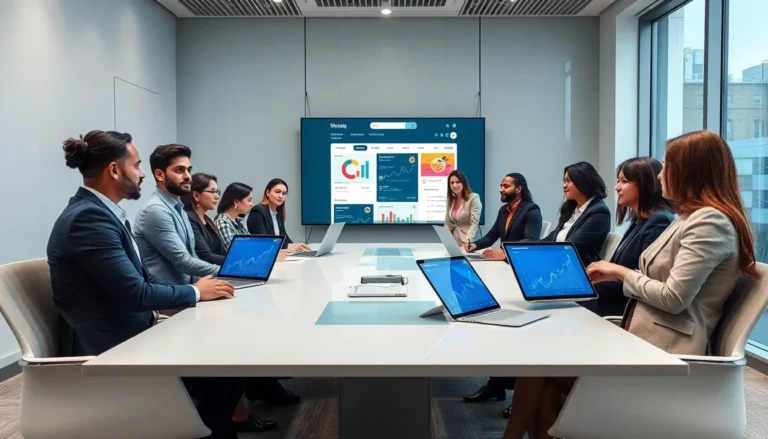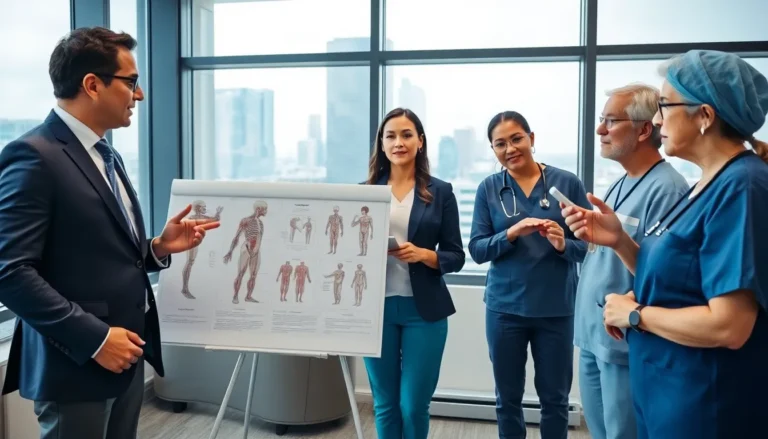Table of Contents
ToggleIn a world where time is money and every second counts, finding efficient ways to handle tasks is crucial. Enter ChatGPT, your new best friend for transcription. Forget the days of listening to audio on repeat or struggling with messy handwritten notes. With ChatGPT, transcribing is as easy as pie—if pie could type, that is.
Understanding ChatGPT
ChatGPT serves as an advanced language processing tool developed by OpenAI. This AI technology uses deep learning to generate human-like text, making it an asset for various tasks including transcription. Users appreciate its ability to understand context and maintain coherent conversations.
The model operates based on extensive training data, allowing it to recognize and transcribe spoken language accurately. Its adaptability enables it to handle different accents and speech patterns effectively. Users find this beneficial when transcribing interviews, lectures, or meetings.
Interaction with ChatGPT is straightforward. Users can input audio files or dictate text, and the AI produces a transcript almost instantly. The accuracy of transcription depends on the clarity of the audio input, but improvements continue thanks to ongoing updates and refinements.
Additionally, ChatGPT supports various formats, accommodating users’ needs for specific transcription styles. Whether requiring verbatim accounts or summaries, it caters to those preferences seamlessly. Users enjoy the ease with which they can refine their requests, driving improved outcomes.
A growing number of individuals and organizations leverage ChatGPT for transcription tasks. Productivity increases as repetitive playback and manual note-taking diminish. ChatGPT simplifies the transcription process, allowing users to focus more on content rather than mechanics.
Benefits of Using ChatGPT for Transcription

ChatGPT offers several advantages for transcription tasks. Users experience increased efficiency and accuracy, leading to streamlined workflows.
Time Efficiency
The use of ChatGPT significantly reduces the time spent on transcription. Instead of manually replaying audio files multiple times, it processes audio quickly, transforming speech into written text almost instantly. Rapid transcription allows users to focus on analyzing content rather than the mechanical aspects of note-taking. Furthermore, its ability to handle different accents and speech patterns means fewer misunderstandings and corrections, which saves additional time. As a result, users can complete projects faster, enhancing overall productivity.
Cost-Effectiveness
Utilizing ChatGPT for transcription presents a cost-effective solution for individuals and organizations. By minimizing the need for professional transcription services, it lowers expenses associated with hiring freelancers or purchasing software. Furthermore, it operates on a flexible pricing model, making it accessible for various budgets. Users can significantly cut costs while still enjoying high-quality transcriptions. Additionally, the efficiency gains translate into more time available for other important tasks, maximizing the return on investment.
Getting Started with ChatGPT
To use ChatGPT efficiently for transcription, users must follow a few initial steps. These steps make accessing the tool straightforward and intuitive.
Setting Up Your Account
Creating an account enables access to ChatGPT’s transcription features. Users can visit the OpenAI website to sign up. After entering email information and creating a password, confirmation is usually necessary for account activation. Once set, individuals can explore subscription options that fit their needs, choosing between free and premium access levels. Premium accounts offer enhanced features and prioritized access during high-traffic periods. Users can manage their subscription settings through the account dashboard, ensuring access aligns with their transcription demands.
Accessing the ChatGPT Interface
Navigating the ChatGPT interface is user-friendly. Users can log in using their newly created credentials and find a clean, straightforward layout. The main text input area appears prominently, allowing users to input text or audio file links. Additionally, an instructional sidebar often provides tips for efficient use. This interface supports real-time feedback, enabling instant editing and adjustments. Users can also access historical conversations for reference, facilitating a smoother transcription process. Overall, the design enhances usability, making it easier for individuals to focus on transcription tasks.
Techniques for Effective Transcription
Utilizing ChatGPT for transcription involves specific techniques that enhance both speed and precision.
Best Practices for Inputting Audio
Clarity in audio input plays a crucial role in transcription quality. Users should ensure that recordings are free from background noise. A clear and crisp recording enhances ChatGPT’s understanding of speech patterns. When possible, choose high-quality microphones for capturing audio. Breaking longer recordings into manageable clips promotes better parsing by the AI. Its capabilities shine especially when speakers articulate clearly and maintain consistent volume levels. Users can also label speakers in recordings, allowing ChatGPT to differentiate voices for better context in transcripts.
Fine-Tuning Outputs for Accuracy
Reviewing transcription outputs significantly improves accuracy. After obtaining a transcript, users can compare it against the original audio for discrepancies. Making adjustments to phrases or terms that ChatGPT misinterprets enhances the overall result. When necessary, adjusting settings related to verbosity allows users to receive more concise outputs. Some individuals prefer requesting a summary rather than a verbatim transcript, tailoring the content more closely to specific needs. Utilizing feedback options within the ChatGPT interface can also lead to improved performance over time, as it learns from corrections. Adopting these strategies ensures transcripts are not only efficient but also precise.
Limitations of ChatGPT in Transcription
ChatGPT, while beneficial for transcription tasks, has notable limitations. Users should consider these challenges to improve their experience.
Handling Complex Language
Transcription accuracy can decrease with complex language. When speakers use jargon, technical terms, or idiomatic expressions, ChatGPT may struggle to interpret meaning effectively. Contextual nuances often escape the model, leading to potential misunderstandings. This limitation is particularly relevant in specialized fields. Professionals in law or medicine may find that complicated terminology requires manual validation. Users should be prepared to refine transcripts for clarity, ensuring precise representation of complex ideas.
Dealing with Background Noise
Background noise proves problematic for transcription quality. Sounds from conversations, traffic, or music can interfere with audio clarity. ChatGPT relies heavily on clear input to generate accurate transcripts. Users experiencing noisy environments may not achieve the desired result. It’s essential to have high-quality recordings, as poor audio affects transcription reliability. Investing in better recording equipment or finding quieter spaces can mitigate these challenges. By controlling the audio environment, users increase the likelihood of obtaining accurate transcripts.
ChatGPT stands out as a powerful ally for anyone tackling transcription tasks. Its ability to quickly convert audio into text streamlines workflows and enhances productivity. By leveraging its user-friendly interface and advanced language processing capabilities, individuals can focus more on content rather than the mechanics of transcription.
While it’s essential to be mindful of its limitations, such as challenges with complex language and background noise, users can significantly improve their experience by following best practices. With ongoing advancements and updates, ChatGPT is poised to remain a valuable tool for efficient and accurate transcription in various settings. Embracing this technology can lead to more effective communication and better time management.








